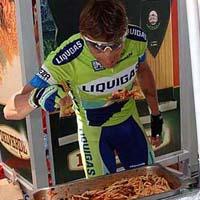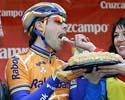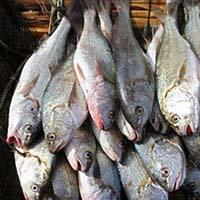
Recently on Cyclingnews.com |
May 6, 2009
Eating advice for every day people

|
The large variety of diet options purported by so-called 'gurus' may become overwhelming for someone looking to shed a few pounds. Cycling Plus' Christine Bailey takes you through some simple steps to 'sharpen your edges' whilst keeping your nutrition needs smoothed.
No matter what kind of rider you are, it's all too easy to suffer from an expanding midsection. Not only can this hamper your performance, it can also affect your overall health.
The key to long-term weight loss is not merely counting calories or carbs, but instead following a programme designed to reshape your body, improving its composition and maintaining power.
Fundamental to this is balancing blood sugar levels, which is critical for losing fat, promoting muscle mass and hence boosting energy and performance. Adopting the following principles and eating plan will not only produce results fast, but it will also improve your performance and overall health.

|
Eat little and often
It's essential for cyclists to keep the body fuelled frequently with the right foods, which ensures a steady supply of glucose entering the bloodstream to be converted into energy. This reduces the insulin response as well, enabling the body to burn fat rather than store it, which means effective, healthy weight loss paired with constant energy levels.
Two to three hours after eating, your blood glucose levels drop, so you should aim to eat around every three hours even if you're not training. In practical terms, this means eating breakfast, a healthy mid-morning snack, lunch, another healthy snack in the afternoon and an evening meal.
Join the Cyclingnews Form & Fitness Forum
for your chance to talk with our panel of experts. Simply log onto our
During
training sessions, or all-day rides, you may want to add an additional snack
or two. Choose these with care - treat them like mini-meals and make them count
nutritionally. You can pick various foods to suit different times, such as when
you need to hydrate, aid recovery or provide your body with additional nutrients.
Here are some examples:
Get involved
![]()
Form
& Fitness Forum
To find out more...
* Pots of natural low-fat yoghurt, cottage cheese or fromage frais and fruit
* Pots of hummus, guacamole or fish pate with a handful of carrot, pepper, cucumber
and celery sticks
* Nut and seed bars (no added sugar)
* Piece of fruit with 30g of hard cheese
* Plain popcorn, crackers or pretzels - combine with some protein
* Oat cakes or pumpernickel bread
* Hard-boiled egg and vegetable sticks
* Flavoured low-fat milkshakes
* Miso soup and lean ham/chicken
* Homemade trail mix - combine a variety of nuts, dried fruit and mini plain
shredded wheat to snack on
Typical menu* Breakfast: Protein boosting porridge made with porridge oats, milk or water and a half scoop of protein powder or ground seeds. Top with yoghurt and half a cup of berries or fruit. * Mid-morning snack: One bit of fruit plus some nuts and seeds. * Lunch: Mixed bean or chicken salad using half a can of mixed beans and at least five different vegetables, sprouted seeds and dressed using an omega-blend oil. One slice of rye or pumpernickel bread spread with pumpkin seed butter or tahini. * Mid-afternoon snack: One protein shake * Dinner: Seared salmon with steamed vegetables and half a cup of cooked buckwheat noodles. Use a palm-sized piece of fish and wide selection of vegetables. |
Include protein
Many weight loss diets fail to work and also result in a loss of muscle mass, leading to a slower metabolism, less fat loss and even weight gain. This is where including sufficient protein in your diet can help. After all, your muscles are mostly made up of protein.
Including protein has other important benefits, too - it slows down the rate of digestion and the speed at which sugars are released into the bloodstream, helping you to feel fuller for longer and thus reducing appetite. Because your blood sugar doesn't vary so dramatically, you're also less likely to suffer from cravings and, as a result, overeating.
Not all proteins are as beneficial for your health as others, though: red meat and dairy foods contain a high proportion of saturated fats. While it's fine to have the odd steak, try to include more lean poultry, eggs, vegetarian protein foods and fish (particularly oily fish: a good source of anti-inflammatory omega 3 fats).
Quick tip: A portion is roughly 75g to 100g in weight, which is about the size of the palm of your hand. This is equal to two eggs or three egg whites plus an egg yolk. For beans and pulses, it's 125g/half a cup (cooked).
Fill just over a third of your plate (30 to 40 per cent) with protein and combine this with a range of colourful veggies, which contain vitamins, minerals and fibre that help counter the acidity of protein-based foods.
Cut out the junk
Sugar comes in many disguises, whether it's sucrose, glucose, sorbitol, corn sugar, malt, molasses, golden, rice or maple syrup. All of these can contribute to unstable sugar levels, insulin resistance and weight gain.
Focus more on wholegrains (oats, barley, quinoa, rye) - the fibre helps to control cravings and maintain even energy levels when on your bike. Fast sugar-releasing fruits and juice are fine pre, post and during rides, but eat or drink them too often and it can send your sugar levels soaring. Mix them with slower releasing, antioxidant-rich berries, citrus fruits, apples and pears.
Eat essential fats

|
Forget low-fat, calorie-counting diets; eating the right type of fat is crucial for losing weight. The essential fats are those the body cannot make itself and so must be obtained from food.
Known as omega 3, 6 and essential fatty acids, they help your body to make hormone-like substances (called prostaglandins) that control your metabolism and reduce inflammation. This means that such fats are used by your body to help you burn off excess fat and improve the levels of both cholesterol and triglycerides in your blood.
The omega 3 fats found in oily fish such as salmon, trout, mackerel, sardines and herring, and some nuts and seeds, including flaxseed, hemp and walnuts, are typically lacking in the diet. Aim to eat oily fish at least twice a week and try to include a range of nuts, seeds and omega oils in your diet daily. Monounsaturated fat is also beneficial, so you can snack on avocados drizzled with olive oil.
Get supplementary help
To keep your blood sugar levels stable, it may be useful to supplement your diet. Start with a high strength multivitamin and mineral formula containing between 20 to 50mg of each of the key B vitamins (B1, B2, B3, B6) needed for energy production, at least 1g of vitamin C and an essential omega supplement.
You may wish to add other nutrients known to help stabilise blood sugar and burn fat - top choices for this include chromium, magnesium, alpha lipoic acid, conjugated linolenic acid (CLA) and protein supplements or powders. Getting the quantities right can be difficult, so it's worth seeking support from a nutritionist in order to tailor a programme to suit your needs.
